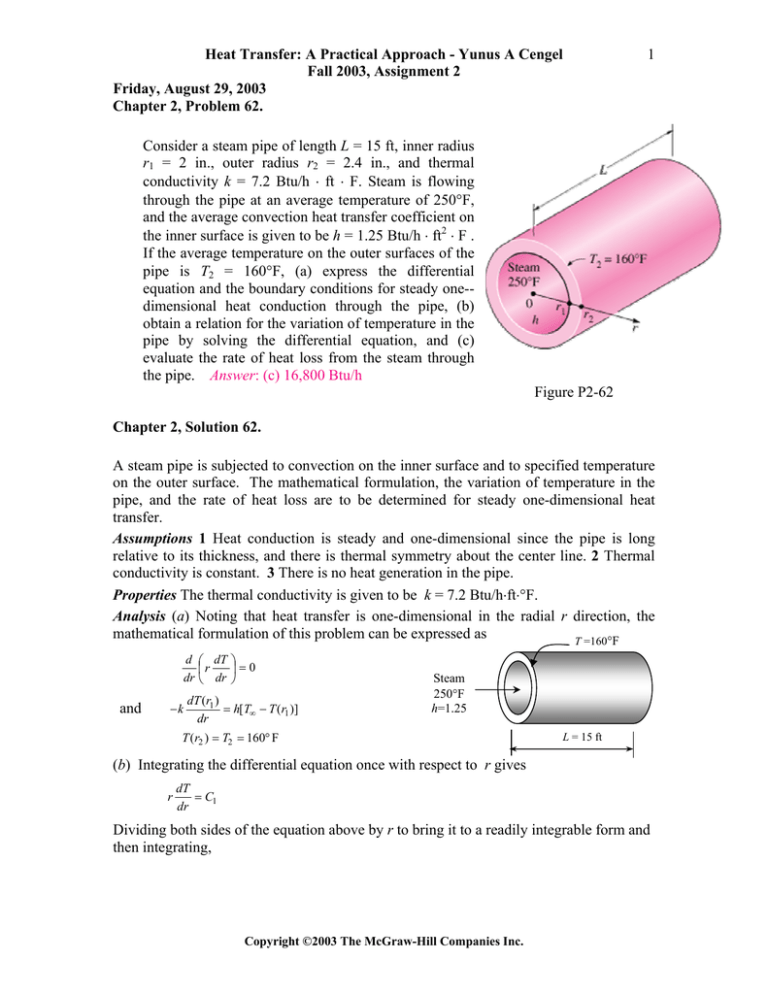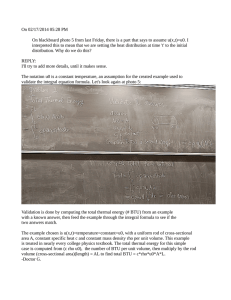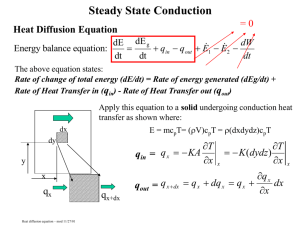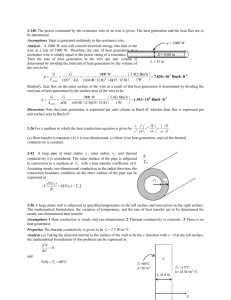Solutions ()
advertisement

Heat Transfer: A Practical Approach - Yunus A Cengel Fall 2003, Assignment 2 Friday, August 29, 2003 Chapter 2, Problem 62. 1 Consider a steam pipe of length L = 15 ft, inner radius r1 = 2 in., outer radius r2 = 2.4 in., and thermal conductivity k = 7.2 Btu/h ⋅ ft ⋅ F. Steam is flowing through the pipe at an average temperature of 250°F, and the average convection heat transfer coefficient on the inner surface is given to be h = 1.25 Btu/h ⋅ ft2 ⋅ F . If the average temperature on the outer surfaces of the pipe is T2 = 160°F, (a) express the differential equation and the boundary conditions for steady one-dimensional heat conduction through the pipe, (b) obtain a relation for the variation of temperature in the pipe by solving the differential equation, and (c) evaluate the rate of heat loss from the steam through the pipe. Answer: (c) 16,800 Btu/h Figure P2-62 Chapter 2, Solution 62. A steam pipe is subjected to convection on the inner surface and to specified temperature on the outer surface. The mathematical formulation, the variation of temperature in the pipe, and the rate of heat loss are to be determined for steady one-dimensional heat transfer. Assumptions 1 Heat conduction is steady and one-dimensional since the pipe is long relative to its thickness, and there is thermal symmetry about the center line. 2 Thermal conductivity is constant. 3 There is no heat generation in the pipe. Properties The thermal conductivity is given to be k = 7.2 Btu/h⋅ft⋅°F. Analysis (a) Noting that heat transfer is one-dimensional in the radial r direction, the mathematical formulation of this problem can be expressed as T =160°F d dr and −k ⎛ dT ⎞ ⎟=0 ⎜r ⎝ dr ⎠ dT (r1 ) = h[T∞ − T (r1 )] dr Steam 250°F h=1.25 T (r2 ) = T2 = 160° F L = 15 ft (b) Integrating the differential equation once with respect to r gives r dT = C1 dr Dividing both sides of the equation above by r to bring it to a readily integrable form and then integrating, Copyright ©2003 The McGraw-Hill Companies Inc. Heat Transfer: A Practical Approach - Yunus A Cengel Fall 2003, Assignment 2 Friday, August 29, 2003 2 dT C1 = dr r T (r ) = C1 ln r + C2 where C1 and C2 are arbitrary constants. Applying the boundary conditions give C1 = h[T∞ − (C1 ln r1 + C2 )] r1 r = r1: −k r = r2: T (r2 ) = C1 ln r2 + C2 = T2 Solving for C1 and C2 simultaneously gives C1 = T2 − T∞ r k ln 2 + r1 hr1 and C2 = T2 − C1 ln r2 = T2 − T2 − T∞ ln r2 r k ln 2 + r1 hr1 Substituting C1 and C2 into the general solution, the variation of temperature is determined to be T (r ) = C1 ln r + T2 − C1 ln r2 = C1 (ln r − ln r2 ) + T2 = = T 2 − T∞ r ln + T2 r2 k r2 ln + r1 hr1 (160 − 250)°F r r ln + 160°F = −24.74 ln + 160°F 2.4 7.2 Btu/h ⋅ ft ⋅ °F 2 . 4 in 2 . 4 in ln + 2 (12.5 Btu/h ⋅ ft 2 ⋅ °F)(2 / 12 ft ) (c) The rate of heat conduction through the pipe is C T 2 − T∞ dT = −k (2πrL ) 1 = −2πLk Q& = −kA r k dr r ln 2 + r1 hr1 (160 − 250)°F = −2π (15 ft)(7.2 Btu/h ⋅ ft ⋅ °F) = 16,800 Btu/h 2.4 7.2 Btu/h ⋅ ft ⋅ °F + ln 2 (12.5 Btu/h ⋅ ft 2 ⋅ °F)(2 / 12 ft ) NOTE: if instead use h = 1.25 Btu/h-ft2-F (as was stated in the problem in text) then we get (160 − 250)°F r r T (r ) = ln + 160°F = −2.590 ln + 160°F 2 .4 7.2 Btu/h ⋅ ft ⋅ °F 2.4 in 2.4 in ln + 2 (1.25 Btu/h ⋅ ft 2 ⋅ °F)(2 / 12 ft ) and the heat transfer rate is (160 − 250)°F Q& = −2π (15 ft)(7.2 Btu/h ⋅ ft ⋅ °F) = 1758 Btu/h 2 .4 7.2 Btu/h ⋅ ft ⋅ °F ln + 2 (1.25 Btu/h ⋅ ft 2 ⋅ °F)(2 / 12 ft ) Copyright ©2003 The McGraw-Hill Companies Inc. Heat Transfer: A Practical Approach - Yunus A Cengel Fall 2003, Assignment 2 Friday, August 29, 2003 3 Chapter 2, Problem 84. Consider a large 5-cm-thick brass plate (k = 111 W/m ⋅ °C) in which heat is generated uniformly at a rate of 2 × 105 W/m3. One side of the plate is insulated while the other side is exposed to an environment at 25°C with a heat transfer coefficient of 44 W/m2 ⋅ °C. Explain where in the plate the highest and the lowest temperatures will occur, and determine their values. Figure P2-84 Chapter 2, Solution 84. Heat is generated uniformly in a large brass plate. One side of the plate is insulated while the other side is subjected to convection. The location and values of the highest and the lowest temperatures in the plate are to be determined. Assumptions 1 Heat transfer is steady since there is no indication of any change with time. 2 Heat transfer is one-dimensional since the plate is large relative to its thickness, and there is thermal symmetry about the center plane 3 Thermal conductivity is constant. 4 Heat generation is uniform. Properties The thermal conductivity is given to be k =111 W/m⋅°C. Analysis This insulated plate whose thickness is L is equivalent to one-half of an uninsulated plate whose k thickness is 2L since the midplane of the uninsulated g plate can be treated as insulated surface. The highest T∞ =25°C temperature will occur at the insulated surface while the Insulated h=44 W/m2.°C lowest temperature will occur at the surface which is L=5 cm exposed to the environment. Note that L in the following relations is the full thickness of the given plate since the insulated side represents the center surface of a plate whose thickness is doubled. The desired values are determined directly from T s = T∞ + g& L ( 2 × 10 5 W/m 3 )(0.05 m) = 25°C + = 252.3 °C h 44 W/m 2 .°C To = T s + g&L2 (2 × 10 5 W/m 3 )(0.05 m) 2 = 252.3°C + = 254.5 °C 2k 2(111 W/m.°C) Copyright ©2003 The McGraw-Hill Companies Inc. 4 Heat Transfer: A Practical Approach - Yunus A Cengel Fall 2003, Assignment 2 Friday, August 29, 2003 Chapter 2, Problem 89. Consider a homogeneous spherical piece of radioactive material of radius r0 = 0.04 m that is generating heat at a constant rate of g = 4 × 107 W/m3. The heat generated is dissipated to the environment steadily. The outer surface of the sphere is maintained at a uniform temperature of 80°C and the thermal conductivity of the sphere is k = 15 W/m ⋅ °C. Assuming steady one-dimensional heat transfer, (a) express the differential equation and the boundary conditions for heat conduction through the sphere, (b) obtain a relation for the variation of temperature in the sphere by solving the differential equation, and (c) determine the temperature at the center of the sphere. Figure P2-89 Chapter 2, Solution 89. Heat is generated uniformly in a spherical radioactive material with specified surface temperature. The mathematical formulation, the variation of temperature in the sphere, and the center temperature are to be determined for steady one-dimensional heat transfer. Assumptions 1 Heat transfer is steady since there is no indication of any changes with time. 2 Heat transfer is one-dimensional since there is thermal symmetry about the mid point. 3 Thermal conductivity is constant. 4 Heat generation is uniform. Properties The thermal conductivity is given to be k = 15 W/m⋅°C. Analysis (a) Noting that heat transfer is steady and one-dimensional in the radial r direction, the mathematical formulation of this problem can be expressed as 1 d ⎛ 2 dT ⎞ g& ⎜r ⎟+ = 0 dr ⎠ k r 2 dr ⎝ and T (r0 ) = Ts = 80°C dT (0) =0 dr with g& = constant (specified surface temperature) (thermal symmetry about the mid point) (b) Multiplying both sides of the differential equation by r2 and rearranging gives g& 2 d ⎛ 2 dT ⎞ ⎜r ⎟=− r dr ⎝ dr ⎠ k Integrating with respect to r gives r2 dT g& r 3 =− + C1 dr k 3 (a) 0 Applying the boundary condition at the mid point, B.C. at r = 0: 0 × Ts=80°C k g dT (0) g& =− × 0 + C1 dr 3k → C1 = 0 Copyright ©2003 The McGraw-Hill Companies Inc. ro r 5 Heat Transfer: A Practical Approach - Yunus A Cengel Fall 2003, Assignment 2 Friday, August 29, 2003 Dividing both sides of Eq. (a) by r2 to bring it to a readily integrable form and integrating, and dT g& =− r dr 3k g& T (r ) = − r 2 + C2 6k (b) Applying the other boundary condition at r = r0 , B. C. at r = r0 : Ts = − g& 2 r0 + C2 6k → C2 = Ts + g& 2 r0 6k Substituting this C2 relation into Eq. (b) and rearranging give T (r ) = Ts + g& 2 (r0 − r 2 ) 6k which is the desired solution for the temperature distribution in the wire as a function of r. (c) The temperature at the center of the sphere (r = 0) is determined by substituting the known quantities to be T (0 ) = T s + g&r 2 g& 2 (4 × 10 7 W/m 3 )(0.04 m ) 2 (r0 − 0 2 ) = Ts + 0 = 80°C + = 791°C 6k 6k 6 × (15 W/ m.°C) Thus the temperature at center will be about 711°C above the temperature of the outer surface of the sphere. Copyright ©2003 The McGraw-Hill Companies Inc. 6 Heat Transfer: A Practical Approach - Yunus A Cengel Fall 2003, Assignment 2 Friday, August 29, 2003 Chapter 3, Problem 19. Consider a 1.2-m-high and 2-m-wide double-pane window consisting of two 3-mm-thick layers of glass (k = 0.78 W/m ⋅ °C) separated by a 12-mm-wide stagnant air space (k = 0.026 W/m ⋅ °C). Determine the steady rate of heat transfer through this doublepane window and the temperature of its inner surface for a day during which the room is maintained at 24°C while the temperature of the outdoors is 25°C. Take the convection heat transfer coefficients on the inner and outer surfaces of the window to be h1 = 10 W/m2 ⋅ °C and h2 = 25 W/m2 ⋅ °C, and disregard any heat transfer by radiation. Answers: 114 W, 19.2°C Figure 3.19 Chapter 3, Solution 19 A double-pane window consists of two 3-mm thick layers of glass separated by a 12-mm wide stagnant air space. For specified indoors and outdoors temperatures, the rate of heat loss through the window and the inner surface temperature of the window are to be determined. Assumptions 1 Heat transfer through the window is steady since the indoor and outdoor temperatures remain constant at the specified values. 2 Heat transfer is one-dimensional since any significant temperature gradients will exist in the direction from the indoors to the outdoors. 3 Thermal conductivities of the glass and air are constant. 4 Heat transfer by radiation is negligible. Properties The thermal conductivity of the glass and air are given to be kglass = 0.78 W/m⋅°C and kair = 0.026 W/m⋅°C. Analysis The area of the window and the individual resistances are A = (1.2 m) × ( 2 m) = 2.4 m 2 1 1 = = 0.0417 °C/W h1 A (10 W/m 2 .°C)(2.4 m 2 ) 0.003 m L R1 = R3 = Rglass = 1 = = 0.0016 °C/W k1 A (0.78 W/m.°C)(2.4 m 2 ) 0.012 m L R2 = Rair = 2 = = 0.1923 °C/W k2 A (0.026 W/m.°C)(2.4 m 2 ) 1 1 Ro = Rconv,2 = = = 0.0167 o C/W 2 o h2 A (25 W/m . C)(2.4 m 2 ) Rtotal = Rconv,1 + 2 R1 + R2 + Rconv,2 = 0.0417 + 2(0.0016) + 0.1923 + 0.0167 Air Ri = Rconv,1 = Ri T∞1 = 0.2539 °C/W Copyright ©2003 The McGraw-Hill Companies Inc. R1 R2 R3 Ro T∞2 Heat Transfer: A Practical Approach - Yunus A Cengel Fall 2003, Assignment 2 Friday, August 29, 2003 The steady rate of heat transfer through window glass then becomes T −T [24 − (−5)]°C Q& = ∞1 ∞ 2 = = 114 W Rtotal 0.2539°C/W The inner surface temperature of the window glass can be determined from T −T ⎯→ T1 = T∞1 − Q& Rconv,1 = 24 o C − (114 W)(0.0417°C/W) = 19.2°C Q& = ∞1 1 ⎯ Rconv,1 Copyright ©2003 The McGraw-Hill Companies Inc. 7 Heat Transfer: A Practical Approach - Yunus A Cengel Fall 2003, Assignment 2 Friday, August 29, 2003 8 Chapter 3, Problem 24. Consider a power transistor that dissipates 0.2 W of power in an environment at 30°C. The transistor is 0.4 cm long and has a diameter of 0.5 cm. Assuming heat to be transferred uniformly from all surfaces, determine (a) the amount of heat this resistor dissipates during a 24-h period, in kWh; (b) the heat flux on the surface of the transistor, in W/m2; and (c) the surface temperature of the resistor for a combined convection and radiation heat transfer coefficient of 18 W/m2 ⋅ °C. Figure P3-24 Chapter 3, Solution 24 A power transistor dissipates 0.2 W of power steadily in a specified environment. The amount of heat dissipated in 24 h, the surface heat flux, and the surface temperature of the resistor are to be determined. Assumptions 1 Steady operating conditions exist. 2 Heat is transferred uniformly from all surfaces of the transistor. Analysis (a) The amount of heat this transistor dissipates during a 24-hour period is Q = Q& ∆t = (0.2 W)(24 h) = 4.8 Wh = 0.0048 kWh Air, 30°C (b) The heat flux on the surface of the transistor is πD 2 + πDL 4 π (0.005 m) 2 =2 + π (0.005 m)(0.004 m) = 0.0001021 m 2 4 Q& 0. 2 W = = 1959 W/m 2 q& = As 0.0001021 m 2 As = 2 (c) The surface temperature of the transistor can be determined from Q& (0.2 W) = 30°C + = 138.8°C Q& = hAs (Ts − T∞ ) → Ts = T∞ + 2 hAs (18 W/m - C)(0.0001021 m 2 ) Copyright ©2003 The McGraw-Hill Companies Inc. Power Transistor 0.2 W




